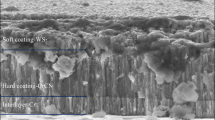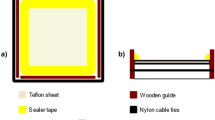Abstract
In machining operations, mechanically clamped, brazed and bonded cutting tools are utilized. The bonded cutting tools have some advantages over the others especially in precision processes. But, there is not much application due to their low joint strength. Therefore, in this study, turning performance of bonded cutting tools was investigated. Nanographene particle-reinforced epoxy or multi-walled carbon nanotube (MWCNT) particle-reinforced epoxy-based nanocomposite adhesives were produced to enhance the adhesive shear strength and joint tensile strength of epoxy adhesive. Steel–cemented carbide (WC, tungsten carbide)–steel single lap joints were produced by applying these nanocomposite adhesives and neat epoxy-based adhesive to specify the optimum amount of nanoparticle reinforcement. Then, machining operations were performed with inserts attached to the tool holder with mechanical clamping method, neat epoxy adhesive and epoxy-based nanocomposite adhesives by utilizing a CNC lathe. The cutting forces, cutting temperatures and surface roughnesses were measured, and the results were compared by each other. Depending on the experimental results, lower cutting forces and surface roughnesses occurred when using bonded cutting tools than that obtained when using mechanical clamping due to damping properties of the adhesive layer. However, the cutting temperatures measured on the bonded cutting tools were higher than that measured on the mechanical clamped cutting tools because of the low thermal conductivity of the adhesive layer. In addition, it was observed that the nanoparticle-reinforced epoxy-based nanocomposite adhesives increased the cutting forces and surface roughnesses a little in comparison with the neat epoxy adhesive due to increasing the viscosity of the neat epoxy and decreasing the damping properties and also decreased the cutting temperatures due to having high thermal conductivity of nanoparticles. When compared the nanoparticles, nanographene adsorbing better on the adherend surface and providing more homogeneous distribution in the matrix gave better results than MWCNT particles.



















Similar content being viewed by others
References
Darwish, S.; Davies, R.: Adhesive bonding of metal cutting tools. Int. J. Mach. Tools Manuf. 29(1), 141–152 (1989)
Darwish, S.; Davies, R.: Investigation of the heat flow through bonded and brazed metal cutting tools. Int. J. Mach. Tools Manuf. 29(2), 229–237 (1989)
Darwish, S.M.; Niazi, A.; Ghaneya, A.: Phase stability of duralumin machined with bonded and brazed carbide tools. Int. J. Mach. Tools Manuf. 32(4), 593–600 (1992)
Darwish, S.M.: Effect of tool bit insert–holder assembly on the quality of machined workpieces. J. Mater. Process. Technol. 105, 230–236 (2000)
Darwish, S.M.: Machining of difficult-to-cut materials with bonded tools. Int. J. Adhes. Adhes. 20, 279–289 (2000)
Al-Samhan, A.; Darwish, S.M.: Factors influencing thermo-mechanical stresses developed in bonded tools. Int. J. Adhes. Adhes. 25, 379–388 (2005)
Al-Samhan, A.M.: Thermal-stresses in carbide-tip bonded face milling cutters. J. King Saud Univ. Eng. Sci. 24, 85–94 (2012)
Kavak, N.; Altan, E.: A new hybrid bonding technique: adhesive-soft soldered joints. Proc. Inst. Mech. Eng. L Mater. Des. Appl. 228(2), 137–143 (2014)
Eryildiz, E.; Uysal, A.; Altan, E.: An experimental investigation on turning performance of cutting tools with bonded insert by MWCNT reinforced nanocomposite. In: 7th International Symposium on Machining, 3–5 November 2016, Istanbul, pp. 394–401
Zhai, L.; Ling, G.; Li, J.; Wang, Y.: The effect of nanoparticles on the adhesion of epoxy adhesive. Mater. Lett. 60, 3031–3033 (2006)
Montazeri, A.; Javadpour, J.; Khavandi, A.; Tcharkhtchi, A.; Mohajeri, A.: Mechanical properties of multi-walled carbon nanotube/epoxy composites. Mater. Des. 31, 4202–4208 (2000)
Yang, S.Y.; Ma, C.C.M.; Teng, C.C.; Huang, Y.W.; Liao, S.H.; Huang, Y.L.; Tien, H.W.; Lee, T.M.; Chiou, K.C.: Effect of functionalized carbon nanotubes on the thermal conductivity of epoxy composites. Carbon 48, 592–603 (2010)
Pilawka, R.; Paszkiewicz, S.; Rostaniec, Z.: Epoxy composites with carbon nanotubes. Adv. Manuf. Sci. Technol. 36(3), 67–79 (2012)
Shiu, S.C.; Tsai, J.L.: Characterizing thermal and mechanical properties of graphene/epoxy nanocomposites. Compos. Part B Eng. 56, 691–697 (2014)
Li, Y.; Zhang, H.; Porwal, H.; Huang, Z.; Bilotti, E.; Peijs, T.: Mechanical, electrical and thermal properties of in situ exfoliated graphene/epoxy nanocomposites. Compos. Part A Appl. Sci. 95, 229–236 (2017)
Wernik, J.M.; Meguid, S.A.: On the mechanical characterization of carbon nanotube reinforced epoxy adhesives. Mater. Des. 59, 19–32 (2014)
Uehara, K.; Sakurai, M.: Bonding strength of adhesives and surface roughness of joined parts. J. Mater. Process. Technol. 127, 178–181 (2002)
Lucic, M.; Stoic, A.; Kopac, J.: Investigation of aluminum single lap adhesively bonded joints. J. Achiev. Mater. Manuf. Eng. 15(1,2), 79–87 (2006)
Chandra, Y.; Scarpa, F.; Adhikari, S.; Zhang, J.; Flores, E.I.S.; Peng, H.X.: Pullout strength of graphene and carbon nanotube/epoxy composites. Compos. Part B Eng. 102, 1–8 (2016)
Zakaria, M.R.; Kudus, M.H.A.; Akil, H.M.; Thirmizir, M.Z.M.: Comparative study of graphene nanoparticle and multiwall carbon nanotube filled epoxy nanocomposites based on mechanical, thermal and dielectric properties. Compos. Part B Eng. 119, 57–66 (2017)
Ramana, G.V.; Padya, B.; Kumar, R.N.; Prabhakar, K.V.P.; Jain, P.K.: Mechanical properties of multi-walled carbon nanotubes reinforced polymer nanocomposites. Indian J. Eng. Mater. Sci. 17, 331–337 (2010)
Zhai, L.L.; Ling, G.P.; Wang, Y.W.: Effect of nano-Al2O3 on adhesion strength of epoxy adhesive and steel. Int. J. Adhes. Adhes. 28, 23–28 (2008)
Gallego, M.M.; Verdejo, R.; Khayet, M.; Zarate, J.M.O.; Essalhi, M.; Manchado, M.A.L.: Thermal conductivity of carbon nanotubes and graphene in epoxy nanofluids and nanocomposites. Nanoscale Res. Lett. 6, 610–616 (2011)
Silva, L.F.M.; Adams, R.D.; Gibbs, M.: Manufacture of adhesive joints and bulk specimens with high-temperature adhesives. Int. J. Adhes. Adhes. 24, 69–83 (2004)
Acknowledgements
This research was supported by Yildiz Technical University Scientific Research Projects Coordination Department (Project Number 2015-06-01-GEP01).
Author information
Authors and Affiliations
Corresponding author
Rights and permissions
About this article
Cite this article
Uysal, A., Eryildiz, E. & Altan, E. Turning Performance of Bonded Cutting Tools with Nanographene or Multi-walled Carbon Nanotube Particle-Reinforced Epoxy-Based Nanocomposite Adhesives. Arab J Sci Eng 44, 7737–7752 (2019). https://doi.org/10.1007/s13369-019-03876-w
Received:
Accepted:
Published:
Issue Date:
DOI: https://doi.org/10.1007/s13369-019-03876-w




